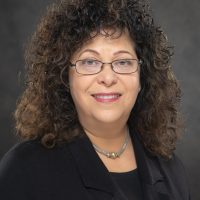Koonin, an original 'architect of social distancing,' develops guidance for COVID-19 response
June 30, 2020

Dr. Lisa M. Koonin
Lisa M. Koonin, DrPH, retired from the United States Centers for Disease Control and Prevention (CDC) at the end of 2018. While she was not expecting the call she received late one night in January 2020, it wasn’t a complete surprise. Koonin had been keeping her eye on an unexplained pneumonia in China since late December 2019.
“That’s always how things start in this scenario,” she said. Researchers will notice “something a little off, and you wait to see if it will catch fire.”
The caller asked Koonin — who is both a UNC Gillings School of Global Public Health alumna and an adjunct faculty member — to come back to work at the emergency operations center that the CDC would activate the next day in response to the COVID-19 pandemic.
In 2018, Koonin had started an enterprise called Health Preparedness Partners to advise organizations on how to prepare for potential infectious disease outbreaks. Following that January call, she worked six or seven days a week for several months, providing consultation and leadership to a team that developed guidance for health care facilities, pharmacies, clinics and hospitals, and shared guidance on the use of telehealth and phone advice lines.
“I got to roll up my sleeves to use all the planning and training that I had done over the years to try and help now,” said Koonin.
Her preparation for this work started years earlier. Koonin had been part of a team developing nonpharmaceutical interventions (NPIs) in response to potential pandemics in 2006 and 2007, which became a source of heightened concern after several new outbreaks of bird flu jumped from animals to infect some humans. The team, led by the CDC in collaboration with Richard Hatchett, MD, and Carter Mecher, MD, examined the 1918 flu pandemic and saw the value of an early coordinated response. The researchers produced official CDC guidance on NPIs, making Koonin one of “architects of social distancing.”
“I’ve actually been thinking about this strategy for a long time,” she said.
When her team presented the initial social distancing guidance, “there was a lot of skepticism and push back” about whether the guidance would work and whether it would be “worth it,” Koonin said. The researchers could not test the guidance, but they could consult modeling studies and the national historical record. Along with another team lead by Howard Markel, MD, PhD, Koonin and her colleagues examined why U.S. cities had varying outcomes during the 1918 pandemic.
Philadelphia and St. Louis, two cities with unique approaches to the 1918 pandemic, had very different outcomes. St. Louis’s quick closure of schools and public gatherings had proven effective.
“We always have to weigh the risks and benefits of a giving medicine or using public health strategy,” Koonin said. “If you’re going to create disruption by implementing social distancing, you want to make sure that there’s a pretty good chance the measure will produce more good than harm. With this severe COVID-19 pandemic, the calculation was that it would.”
Koonin’s journey to public health began “accidentally,” she said, after a short hospitalization at age 14; the work of the medical professionals she encountered fascinated her. She became a nurse, and after receiving on-the-ground training as a nurse practitioner, she went back to school to earn a master’s degree in nursing. Upon enrolling at Emory University, she was informed that the university had just launched a dual Master of Public Health / Master of Nursing program, and Koonin decided to take the plunge. Based on her thesis work, she was recruited to work for the CDC in 1987 with people whom she calls “the smartest in the world,” and she soon became the CDC’s chief of reproductive health surveillance.
Koonin says her time at the Gillings School, where she earned a Doctor of Public Health degree in 2013, prepared her for “leadership positions [she] never would have been offered before.” She served in leadership roles in the responses to Ebola and Zika and would go on to become acting director and then permanent deputy director of the Influenza Coordination Unit at the CDC.
“The leadership training and policy work that we did at Gillings really boosted my skill sets in these positions,” said Koonin.
Her contributions to the field of public health led technology blog The Sociable to name her one of 15 women health care leaders to know in 2020, and her work on social distancing was featured in The New York Times. This recognition is not what motivates her, however
“The whole reason I wake up in the morning is to make a difference,” she said. “If I can make the world a better place for just one person, then I feel like I’m doing my job. I think that emergencies can bring out the very best and worst in people, and one thing we can do is help each other.”
Koonin thinks the United States is starting to see the effects of reopening now and acknowledges that forward progress may have to occur “in fits and starts.”
“People need patience, discipline, flexibility and forbearance,” she said, while lauding the technological advances that have allowed society to practice physical distancing. Looking for a silver lining, she views the pandemic as a spark for future innovation
“I can’t predict what’s going to happen next,” she added, “but I know it’s going to change us dramatically for a long time to come.”
Contact the UNC Gillings School of Global Public Health communications team at sphcomm@unc.edu.
